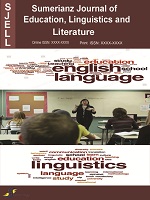Sumerianz Journal of Education, Linguistics and Literature

Online ISSN: 2617-1201
Print ISSN: 2617-1732
Quarterly Published (4 Issues Per Year)
Journal Website: https://www.sumerianz.com/?ic=journal-home&journal=33Archive
Volume 6 Issue 2 (2023)
Entrepreneurship Skills Required by Youths for Effective Participation in Honey Production Occupation in Bayelsa State, Nigeria
Authors : Suwari God’stime Samuel ; Ugo Panebi ; Osemene Emizibo Samuel
DOI : doi.org/10.47752/sjell.62.37.46
Abstract:The study examined the entrepreneurship skills required by youths for effective participation in the honey production occupation in Bayelsa State, Nigeria. The study adopted the descriptive research design. The population for the study, comprised 150 respondents, comprising 70 male and 80 female students of the agricultural education unit in the Department of Vocational and Technology Education, Faculty of Education, Niger Delta University, Bayelsa State, Nigeria from the four different levels viz: 100, 200, 300 and 400 in the 2018/2019 session. The instrument for data collection was a 54-item structured questionnaire on a 4-point rating scale of Strongly Agree (SA), Agree (A), Disagree (D) and Strongly Disagree (SD) with corresponding numerical values of 4, 3, 2, and 1 respectively. The instrument was face-validated by three experts and the Cronbach alpha reliability method was used which yielded a reliability coefficient of 0.62. The data collected were analyzed using weighted mean score while t-test statistics was used for testing the null hypotheses at 0.05 level of significance. The study identified eleven apiculture planning skills, sixteen apiculture management skills, ten preparatory skills for harvesting honey and eleven honey processing skills. There was no significant difference in the mean responses of male and female students of agricultural education on the entrepreneurship skills required by youths for honey production occupation. Based on the findings, the study recommends, among others, that trainers should redouble their efforts to equip learners with entrepreneurship skills in apiculture enterprise. Also, government should intensify campaigns to encourage youths into honey production occupation.
Parental Factor as a Leverage For Adolescents' Criminal Behaviour In South-West, Nigeria
Authors : Dosunmu Simeon. A. ; Sowunmi Rhoda. O.
DOI : doi.org/10.47752/sjell.52.30.37
Abstract:The study investigated the extent to which parental factor act as a leverage for adolescents’ criminal behaviour in South-West, Nigeria. Parental factor includes Parenting styles, Parental criminality, Parent educational achievement, Family type,, Family conflict, and Family financial capability. The Ex-post facto research design was adopted for the study. The simple random as well as purposive sampling technique was used to select adolescents in Juvenile correctional centres and Medium correctional services across South-West Nigeria. A total of 240 participants took part in the study, while data was collected through the responses from the respondents to the Adolescents Criminal Exposure Behaviour Questionnaire (ACEBQ). The data collected was analyzed using the Univariate Analysis of variance [UNIANOVA] at 0.05 level of significance. A significant F- value ( F=4.551:P <0.0 5) The findings revealed that parental factor significantly disposed adolescents in Southwest Nigeria to criminal behaviours and exposure to correctional institutions. This study concluded that parents and guardians need to have firm grip on their wards, so as to prevent them from being negatively influenced by criminally inclined adolescents. The issue of family planning should also be taken seriously, if possible government should mandate couples not to have more than 2 children irrespective of their gender and teaching on dangers and consequences of divorce should be constituted into the counselling sessions for intending couples during their joining at the marriage registry. This is because it was revealed in the course of this research that majority of the adolescents inmates in the correctional institutions visited, were not from intact homes.



